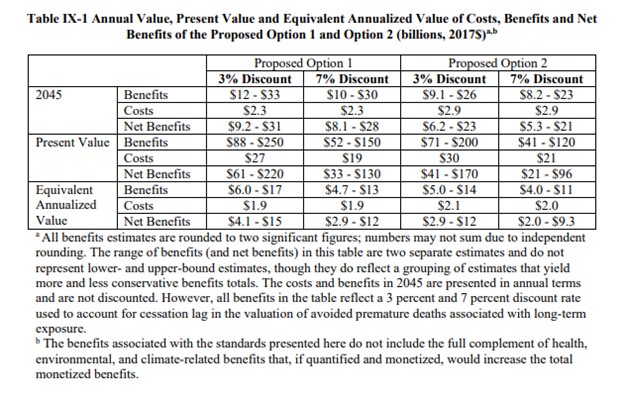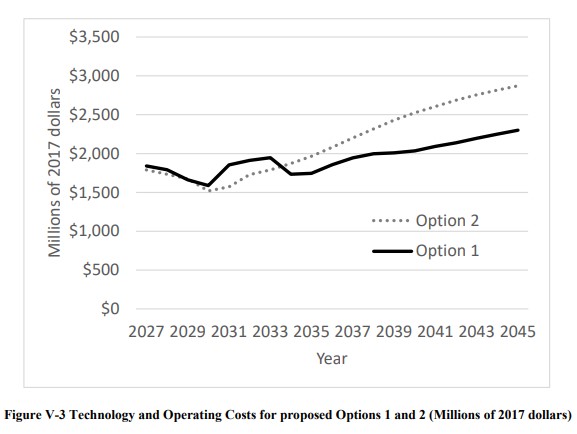Insight
March 9, 2022
First Round of the “Clean Trucks Plan”: Assessing the EPA’s Proposed Heavy-Duty Vehicle Pollution Standards
EXECUTIVE SUMMARY
- The Environmental Protection Agency recently released the first part of its “Clean Trucks Plan,” a proposed rule that would establish tighter standards on various emissions produced by heavy-duty vehicles beginning with model year 2027.
- While the proposal does include modest adjustments to greenhouse gas emissions standards, the regulatory proposal remains primarily focused on “criteria pollutants” such as nitrous oxide, ozone, and particulate matter instead of climate policy.
- The proposed rule provides a wide range of potential cost and benefits estimates, but with cost estimates pushing $30 billion, this action would be the most economically significant rulemaking thus far in 2022.
INTRODUCTION
Last August, the Environmental Protection Agency (EPA) announced its “Clean Trucks Plan” as a result of President Biden’s Executive Order 14,037 entitled “Strengthening American Leadership in Clean Cars and Trucks.” This past week, EPA officially put the Clean Trucks Plan into motion by releasing the first piece of the plan: a proposed rule that would update emissions standards for “criteria pollutants” (including nitrous oxides, particulate matter, hydrocarbons, and carbon monoxide) emanating from heavy-duty vehicles (HDV), such as trucks or buses. These pollutants are not the focus of climate policy, although the proposal also makes modest adjustments to previous regulations regarding HDV greenhouse gas (GHG) emissions standards. Regardless of this focus, the proposed action currently ranks as the most costly rulemaking of 2022 thus far and portends even more expansive regulatory activity coming down the line.
PRIMARY IMPACTS
A key component of EPA’s proposal is that the agency is putting forward two different options under primary consideration. Both begin in covering model year (MY) 2027 and later vehicles, but “Option 1” both sets more stringent emissions levels at the outset and further tightens such standards beginning with MY 2031 vehicles. As one would expect, EPA estimates that the more rigorous set of standards from Option 1 would lead to greater pollutant reductions than Option 2:

In examining the overall cost-benefit analysis, however, there is a curious development in that the agency expects the more aggressive option (Option 1) to yield lower costs:

Per the rulemaking’s analysis, this is because:
The higher projected costs of the proposed Option 2 relative to the proposed Option 1 result from our expectation that the shorter useful life and emission warranty periods of the proposed Option 2 compared to proposed Option 1 in MY 2031 and later would lead to higher emission control system repair costs for proposed Option 2 than the proposed Option 1 (i.e., shorter emissions warranty periods result in higher emission repair costs in proposed Option 2).
As the following graph illustrates, EPA’s contention here is that while the upfront technology costs will be higher for Option 1, the modifications made under that option will result in lesser operating costs going forward than if vehicles simply maintained Option 2-level technology:

CLIMATE IMPACTS
The proposed second – and clearly lesser – component comes in its section on “Targeted Updates to the Phase 2 Heavy-Duty Greenhouse Gas Emissions Program.” EPA expects the second phase of its Clean Trucks Plan to focus more heavily on GHG emissions reduction. In this proposal, however, EPA does plan to make limited changes to its MY 2027 standards (last set by a 2016 rule). Driven primarily by changes in assumptions due to the increased uptake of electric heavy-duty vehicles in particular subsectors in recent years, EPA is proposing “to adjust HD GHG Phase 2 vehicle CO2 emission standards … of school buses, transit buses, delivery trucks, and short-haul tractors and by lowering the applicable CO2 emission standards for these vehicle types in MY 2027 accordingly.”
As EPA explains, these changes will be relatively modest in overall scope. The agency estimates that they would lead to the reduction of 222,000 metric tons of carbon dioxide in 2027 – a mere 0.7 percent decrease from a no-action baseline. Furthermore, EPA expects the technology costs to total $98 million for affected manufacturers. For comparison, the agency cites the $5.2 billion in technology costs from the 2016 rule. The real shifts on this front will come in the second half of the Clean Trucks Plan. According to the most recent Biden Administration regulatory agenda, however, a proposed rule focused on that is still more than a year away.
CONCLUSION
The end of 2021 saw the costliest rule on record: EPA’s latest GHG Standards for Light-Duty Vehicles. The EPA’s first round of its Clean Trucks Plan is far and away the administration’s most significant rulemaking thus far in the new year. While it is not necessarily as focused on climate change as some of the current administration’s recent rhetoric and actions, it marks another step toward a decidedly more assertive EPA than under the preceding administration. Additionally, it is apparently only the first step in a broader regulatory plan for heavy-duty vehicles.










